Delivering data rates up to 10 Gbps and up to 100 W of power, USB Type-C is the new connector for all next generation products. Perfectly tailored for emerging product designs, it offers rich interface capabilities with ‘Alternate mode’ support. Together with these improved capabilities comes easier design and usability with fully reversible plug orientation and cable direction, making USB Type-C far more convenient for consumers and helping deliver a true Plug and Play experience. - Learn More.
NXP USB Type-C is a new Connector Standard billed as the ‘Last Connector’, that will allow multi-function signaling (e.g. USB, Display Port, etc.) to pass over a small form factor, compact, high reliability connector. Signaling for 5Gps USB3 signals to future anticipated 20Gbps will all be available over the same connector.
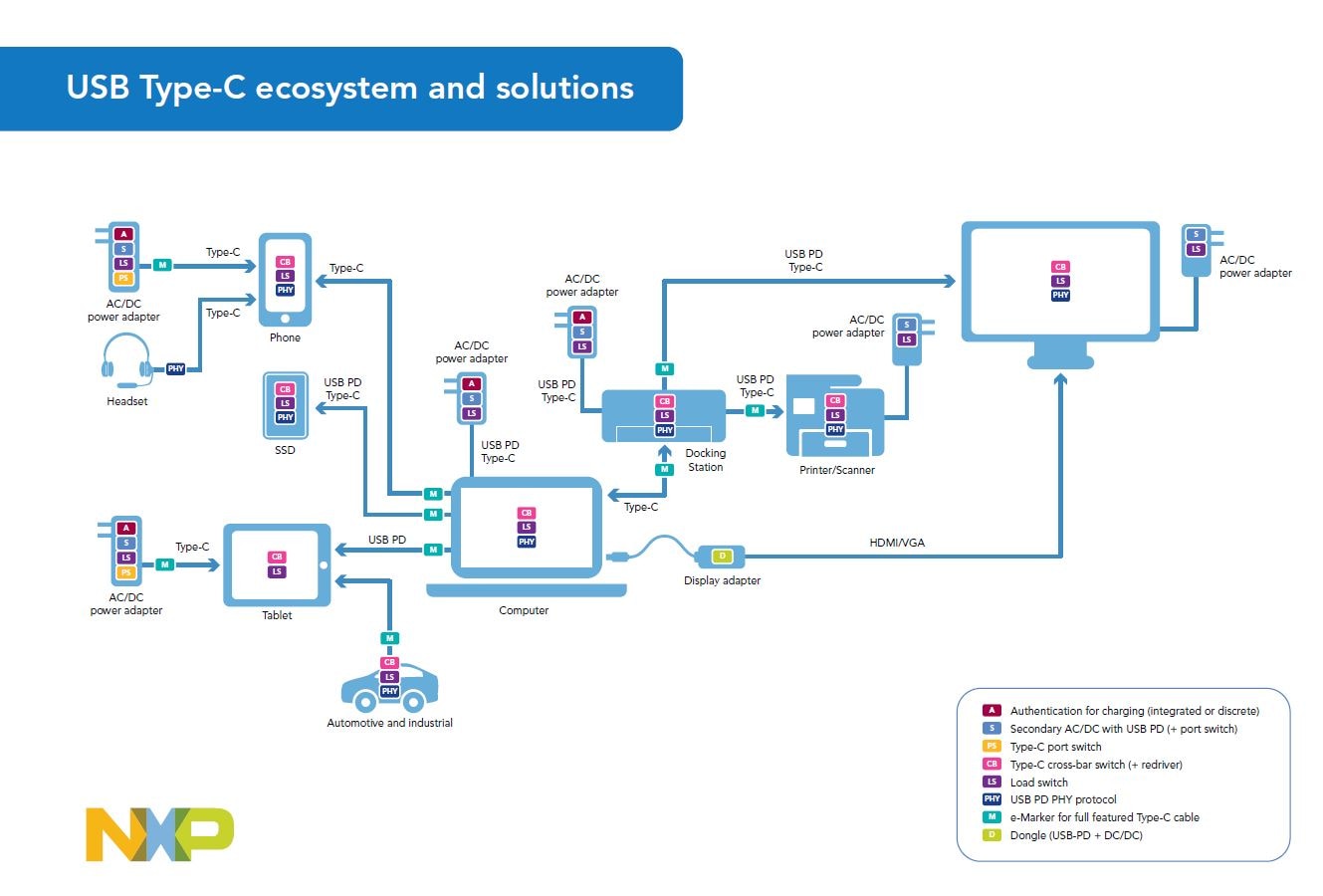 Delivering faster data rates reaching 10 Gbps and up to 100 W of power, USB Type-C is the new connector for all next generation products. Perfectly tailored for emerging product designs, it offers rich interface capabilities with ‘Alternate mode’ support.
NXP’s value proposition in this emerging market is that we provide a broad portfolio of best-in-class solutions for: Delivering faster data rates reaching 10 Gbps and up to 100 W of power, USB Type-C is the new connector for all next generation products. Perfectly tailored for emerging product designs, it offers rich interface capabilities with ‘Alternate mode’ support.
NXP’s value proposition in this emerging market is that we provide a broad portfolio of best-in-class solutions for:
- USB-Power Delivery
- X-Bar Switches
- Microcontrollers
- Authentication
- AC/DC adapter components
- Load Switches and ESD/EMI solutions
Features and Benefits
Seamless connectivity
- Signal transmission at ultra high speed supports growing data and video content
- USB has good potential to lead among the technologies and become the majority / standard connector
One size fits all
- Smaller neat form factor design
- Fully reversible plug orientation and cable direction
- Data, video and power over a single connector
|
Charging ahead
- Fast charging
- Multiple output voltages as defined in the USB-PD standard
- Supports international energy regulations like Energy Star
- USB performance scalability
Secure connectivity built-in
- Enables licensing revenue protection (anti counterfeiting/anti cloning)
- Guarantees peripheral’s safety Brand and IP protection
- Enables new use cases (DRM protection, fast and safe charge)
|
What is USB Type-C AC/DC Solution and why NXP?
What is the USB PD / Type-C AC/DC Solution?
NXP’s high efficient GreenChip QR/DCM Flyback controller TEA1836 in combination with NXP’s Synchronous Rectifier TEA1892 guarantee highest possible efficiency combined with very low stand-by power.
Why are NXP USB Type-C MCUs needed?
Multiple output voltages as defined in the USB-PD standard provide a challenge to meet energy regulations like Energy star, the US Department of Energy (DoE) regulation and the European Code of Conduct (CoC). NXP’s GreenChip solutions help to meet those requirements.
Why NXP?
NXP has a proven track record on high efficiency, low-power standby solutions in Power Supplies and is once more leading the industry with the current offering of the TEA1836 & TEA1892.
TEA1836 – GreenChip SMPS control IC
The TEA18362T is a controller IC for low-cost Switched Mode Power Supplies (SMPS). It is intended for DCM / QR flyback topologies. The built-in green functions provide high efficiency at all power levels.

TEA1892 – GreenChip synchronous rectifier controller
The TEA1892TS is a member of the new generation of Synchronous Rectifier (SR) controller ICs for switched mode power supplies. Its high level of integration allows the design of a cost-effective power supply with a very low number of external components.

What is a Signal Switch and why NXP?
What is a Signal Switch?
Switch provides signal multiplex or de-multiplex function in order to redirect the transmitted signals to same connection port (multiplex switch) or different connection ports (de-multiplex switch).
Why is it needed?
For type-C connector to support “Alternate Mode” or “plug flippable” functions, either multiplex or de-multiplex switch function will be used, or sometimes these functions are combined together to become a cross-point switch.
Why NXP?
Signal switch has no signal regeneration function, and it works at transistor level to redirect the passed signal. The switch architecture design highly impacts the bypassed signal integrity.
NXP’s signal switches provide best-in-class high performance features:
- High signal bandwidth
- Low return loss
- Low crosstalk
- Low jitter disturbance
Switches Overview for USB Type-C Applications
CBTL02043 – 10 GHz High Bandwidth Switch
Using a unique design technique, NXP has minimized the impedance of the switch such that the attenuation observed through the switch is negligible, and also minimized the channel-to-channel skew as well as channel-to-channel crosstalk, as required by the high-speed serial interface.

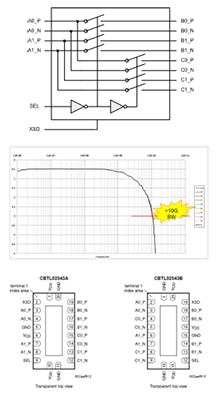
Features and Benefits
- 2 bidirectional differential channel, 2 : 1 multiplexer/demultiplexer
- High-speed signal switching for PCIe Gen3 8 Gbit/s
- High bandwidth: 10 GHz at -3 dB
- Low insertion loss:
- -0.5 dB at 100 MHz
- -1.3 dB at 4.0 GHz
- Low return loss: -13.5 dB at 4 GHz
- Low crosstalk: -35 dB at 4 GHz
- Low off-state isolation: -20 dB at 4 GHz
- Low intra-pair skew: 5 ps typical
- Low inter-pair skew: 35 ps maximum
- VDD operating range: 3.3 V ±10 %
- Shutdown pin (XSD) for power-saving mode
- Standby current less than 1 µA
- ESD tolerance:
- DHVQFN20 package
Applications
- Routing of high-speed differential signals with low signal attenuation
- PCIe Gen3
- DisplayPort 1.2
- USB 3.1
- SATA 6 Gbit/s
| Part Number |
Description |
Datasheet |
|
| CBTL02043 |
IC MUX/DEMUX 2:1 PCI 20DHVQFN |
 |
 |
 Close Close
CBTL04GP043 – Crossbar Switch for USB Type-C Connector
The new USB Type-C connector, built initially on existing USB 3.0 and USB 2.0 technologies, is being developed to help enable thinner and sleeker product designs.

CBTL08GP053 – USB Type-C Combo Switch
CBTL08GP053 is an USB Type-C High Performance Crossbar Switch IC meant to be used for Type-C connector interface high speed passive switching applications. It provides switching of high speed differential signals that correspond to various interface standards: USB3.1 (10 Gbps), DP1.3 (8.1 Gbps), PCI Express 3.0 (8 Gbps), etc. It supports switching of single ended signals over Type-C interface. In addition, side band switching of AUX and other dedicated signals for transport over SBU1 and SBU2.

What are the USB Type-C Load Switches and why NXP?
What is the Type-C Load Switch product?
Advanced unidirectional N-channel power switch designed to automatically isolate a system from a faulty source or load. It includes under-voltage protection, reverse current protection, over-temperature protection, programmable over-voltage protection, and/or programmable current limit
Why is it needed?
Type-C load switches provide protection for 2 main use cases:
- Consumer use-case where the notebook is being charged. The load switches protects the system from OVP surges from faulty wall adapter or external supply, and reverse connector plug-in.
- Provider use-case where the notebook is providing power to an external load (such as On-The-Go). The load switch protects the system from overcurrent, short circuits, and reverse currents caused by a faulty load or upside-down connector plug-in.
Why NXP?
NXP provides simple to implement, yet robust and affordable solutions in a variety of packages.
NX20P5090 – 5 A/20 V Programmable OVP Power Switch
It includes under voltage lockout, over voltage lockout, reverse current protection and over-temperature protection circuits, it is designed to automatically isolate the power switch terminals when a fault condition occurs.

NX5P3090 – 3 A, Adustable Current Limit Power Switch
The device includes under voltage lockout, over-temperature protection, and reverse current protection circuits to automatically isolate the switch terminals when a fault condition occurs.

NX5P2190 – 2 A Load Switch with OCP/OVP/OTP
It includes under-voltage and over-voltage lockout, over-current, over-temperature, reverse bias and in-rush current protection circuits.

NXP USB Type-C MCUs
What are NXP USB Type-C MCUs?
Cost Effective, Small, Low-Power, Industry Leading Microcontroller.
Why are NXP USB Type-C MCUs needed?
- Power negotiation
- Proper timing and response
- Support for different protocols and switching
- Spec compliance
- Authentication
Why NXP?
- Broad range of high performance MCU
- In house USB-PD firmware
- Fully compliant total solution, one stop shopping
- BOM reduction capability, due to flexibility to integrate major functions – USB Type-C and Sensor Hub, or Embedded Controller
LPC1115 – System Standalone MCU
The LPC1110/11/12/13/14/15 are an ARM Cortex-M0 based, low-cost 32-bit MCU family, designed for 8/16-bit microcontroller applications, offering performance, low power, simple instruction set and memory addressing together with reduced code size compared to existing 8/16-bit architectures

LPC54102 – System Integration MCU
Robust power management with on chip power switches and capacitors optimizing energy efficiency with fewer external components

LPC11U35 – USB MCU
Equipped with a highly flexible and configurable full-speed USB 2.0 device controller, the LPC11U35 brings unparalleled design flexibility and seamless integration to today’s demanding connectivity solutions.

What is USB Power Delivery and why NXP?
What is USB PD?
USB PD stands for USB Power Delivery which is the goal of USB connection to provide USB data link and also power from host to device or vice versus from device to host. The maximum power delivery via USB PD 2.0 can be up to 5A and 20V through connector or 3A and 20V through USB cable.
The USB PD protocol is also used to communicate the characteristics of the peripherals with system to establish the link operation
Why is it needed?
USB PD to provide higher power delivery than the legacy USB spec.
Type-C cable adaptor and full-featured Type-C cable electronic marker to communicate the product and/or cable capability information via PD protocol signal.
Alternate mode support to transport non-USB data over Type-C.
Why NXP?
NXP provides optimized system partitioned products with balanced cost and performance.
NXP’s USB PD products and PD Firmware have robust compatibility and complete functions for:
- USB PD 2.0 Physical Layer controller
- USB active cable or cable adaptor controller
- USB Type-C full-featured cable electronic marker
- USB Type-C CC logic controller
PTN5150 – CC Logic Controller
USB PD PHY and Protocol function, Cable/Plug detection and indication, VCONN switch

PTN5100 – USB Type-C PD PHY and Protocol IC
PTN5100 is a single port USB Type-C Power Delivery (PD) PHY and Protocol IC that provides Type-C Configuration channel interface and USB PD Physical and Protocol layer functions to a System PD Port Policy Controller (Policy Engine and Device Policy Manager, Alternate mode controller).

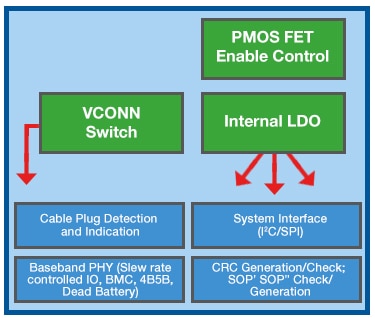
- Application – USB Power Delivery
- Flexible to work with NXP or any 3rd party MCU via SPI or I2C interface
- Power control and related functions
- VBUS (3.7-25V) for local supply
- Baseband PD functions
- Type-C Cable/plug detection and indication (Host, Device and Dual role mode support)
- USB PD Baseband PHY - BMC, 4B5B, Preamble, SOP, SOP’, SOP’’ and EOP generation/reception, CRC generation/check, GoodCRC response
- VCONN Low RON switch (up to 5W max)
- I2C or SPI slave interface
- Power Supply options – VBUS or VDD/VIO
- Package HVQFN20 4mm x 4mm, 0.4 mm pitch
| Part Number |
Description |
Datasheet |
|
| PTN5100BSZ |
USB Type-C power delivery PHY and protocol IC, SPI |
 |
 |
| PTN5100DBSBZ |
USB Type-C power delivery PHY and protocol IC, SPI |
 |
 |
 Close Close
What is a USB signal conditioner and why NXP?
What is a USB signal conditioner?
Signal conditioner is an active signal regenerator which utilizes equalizer and amplifier to reshape the bypassed signal in order to remove jitters and reopen the differential signal eyes for longer channel transmission and reduce the bit error rate.
Why is it needed?
Type-C connector use case would need to transmit or receive USB3 signals through connector, Type-C switch and long trace length. The USB3 redriver can improve the signal eye diagram, extend the link distance and help to pass compliance test.
Why NXP?
NXP provides complete USB3.0 signal conditioners from single channel, dual channel to quad channel configurations in different packages.
NXP’s signal conditioners provide high performance features:
- Programmable equalizer and amplitude settings
- Ultra low active and standby power consumption
- Small outline packages
PTN36221A – 1 channel USB3 Redriver
The PTN36221A is a small, low power, high performance SuperSpeed USB 3.0 redriver that enhances signal quality by performing receive equalization on the deteriorated input signal followed by transmit de-emphasis maximizing system link performance.

| Block Diagrams - Click image to expand |
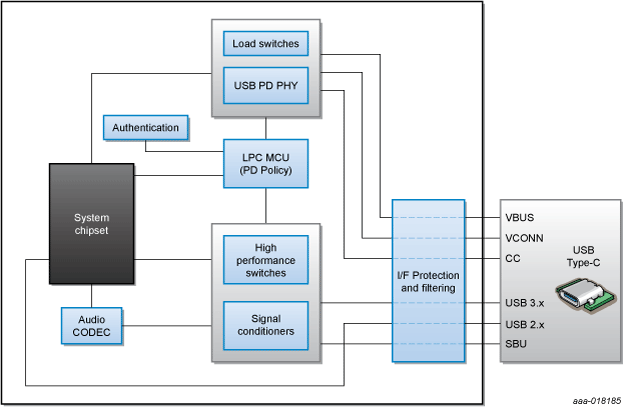
USB Type-C system and accessories |
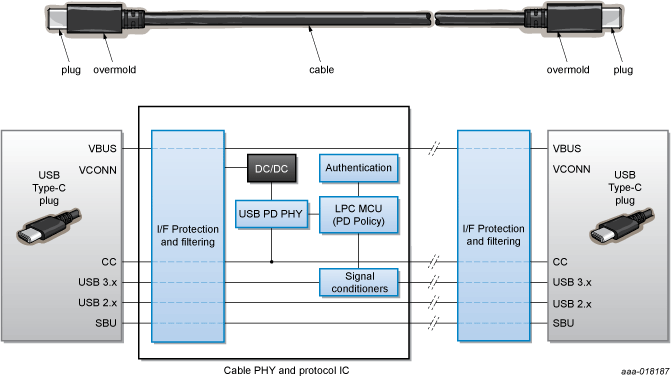
USB Type-C AC/DC wall charger |
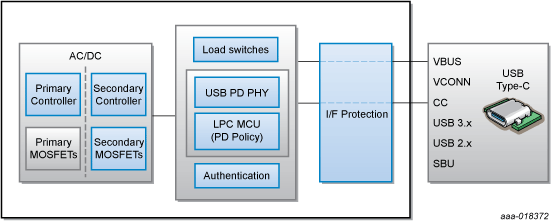
USB Type-C active cable |
| References |
|
Articles
Resources
|
Videos
|
|






















 Close
Close